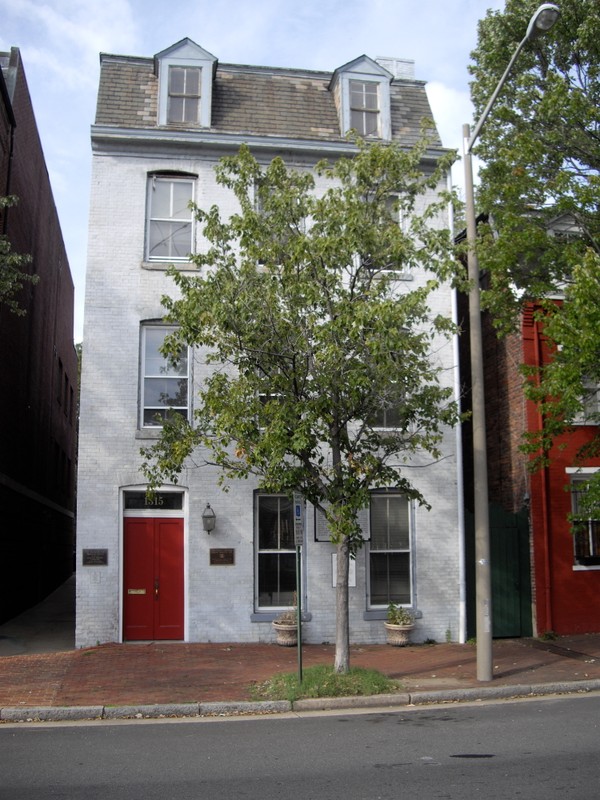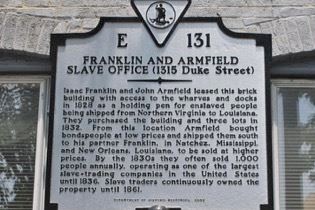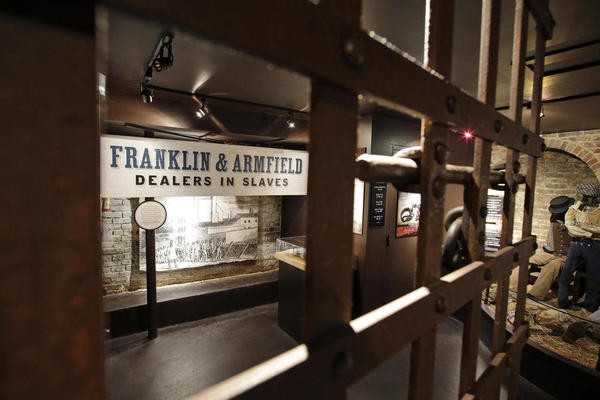Freedom House Museum (Former office of slave trader Franklin and Armfield)
Introduction
Text-to-speech Audio
Images
The former office of slave traders, the building is now home to the Freedom House Museum which is operated by the Northern Virginia Urban League

From 1828 to 1836, Franklin and Armfield sold as many as 1,800 slaves a year to slave owners in Louisiana and Mississippi.

For a period, Franklin and Armfield operated the largest domestic slave trade operation with offices in Virginia and Louisianna.

Backstory and Context
Text-to-speech Audio
Prior to the Civil War, this home was the site of one of the most prosperous slave-trading businesses in the region. At that time, slave pens and markets were located in nearly every town in the South, but a relatively small number of slave trading firms conducted the majority of transactions. Between the 1830s and the end of the Civil War, thousands of men, women, and children passed through slave pens that were part of this building. These individuals were sold near this site and transferred to plantations throughout the South.
The History of Armfield and Franklin
Isaac Franklin was working as a slave trader at least as early as 1819 in Mississippi. Contemporary sources indicate that Franklin was naturally gifted in “the art of buying slaves,” and in 1824 he met a like-minded stagecoach driver by the name of John Armfield. Franklin taught Armfield everything he knew about the trade, and in 1828, the two became partners in what would soon become one of the largest slave trading firms in the United States.
Deciding that Alexandria would be an ideal location to conduct their business, they leased the building at 1315 Duke Street and converted the basement into a slave pen. Franklin managed satellite offices in New Orleans and Natchez, while Armfield stayed and managed affairs at the office in Alexandria. The two men sold thousands of souls into bondage and amassed an enormous fortune in the process. By 1836, the two decided to retire and sold the Alexandria office along with other property, including shops, irons, and human beings.
The Trans-Atlantic Slave Trade was made illegal in 1808, and for those who violated this law, it was punishable by death in 1820. At the same time, the need for slaves in the Deep South grew tremendously which led to the growth of the domestic slave trade (the sale of slaves within the United States remained legal until the ratification of the 13th Amendment in 1865).
From 1828 until the Civil War, an entire block in Alexandria’s Old Time was essentially a pen for a number of slave trade operators. At the building at 1315 Duke Street, Isaac Franklin and John Armfield sold slaves from 1828 to 1836, and during this time, they made an estimate of $1 million and $500,000 (in pre-Civil War dollars) respectively.
To attract slave traders from Virginia and Maryland, Armfield placed advertisements in various newspapers. After purchasing slaves for a low price, he held them in the slave pen until he could arrange transport and/or sale in Franklin, New Orleans, or Natchez, Mississippi. Transport either included one of Armfield and Franklin’s ships or through a 1,000-mile overland walk in slave groups, known as a “coffies.”
After selling the business in 1836, various slave traders took control of the pen, but when Union troops marched through Alexandria during the Civil War, the site was used to house the soldiers, ex-slaves escaping to the North, and Confederate prisoners. For the rest of the 19th century, it served as a boarding house, apartment building, and private residence.
Acquisition by the Urban League
In 1978, the house was listed on the National Register of Historic Places. Later, in 1996, the house was sold to the Northern Virginia Urban League (NOVUL) purchased the building for its operations, which included scholarships, leadership training, financial management skills, and more. The Freedom House Museum was opened in 2008 to commemorate the thousands who passed through the site’s walls before the Civil War. Although the museum carries a harrowing topic, it’s mission is to leave visitors with spirits uplifted and smiles in their hearts. Visitors to the museum report profound feelings when they tour the basement of the building, where thousands of women, men, and children were held as the awaited transport, sale, and separation from family members.
Sources
Photo By Dmadeo (Own work) [CC BY-SA 3.0 (http://creativecommons.org/licenses/by-sa/3.0) or GFDL (http://www.gnu.org/copyleft/fdl.html)], via Wikimedia Commons))
